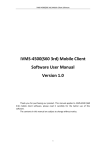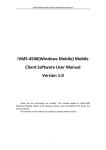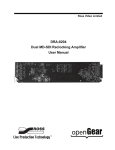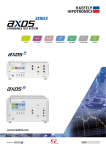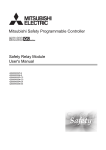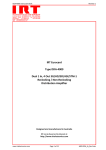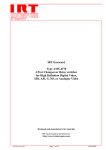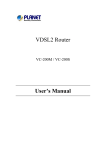Download DVS-4080 User Manual (Revision 00)
Transcript
DVS-4080 3G/HD/SD-SDI / ASI Digital Video Switcher & Router User Manual IRT Electronics Pty Ltd | www.irtelectronics.com Page 1 of 22 Revision 00 DVS-4080 3G/HD/SD-SDI / ASI Digital Video Switcher & Router Revision History: Revision 00 Date 28/06/2013 By AL Change Description Original Issue. Applicable to: Issue 1 boards fitted with Firmware DVS4080F1V0S1V0 IRT Electronics Pty Ltd | www.irtelectronics.com Page 2 of 22 Revision 00 DVS-4080 USER MANUAL Table of Contents: Section Page Revision History Operational Safety General Description Technical Specifications Configuration DIP Switch Settings 8x1 Switcher Quick Set-up Guide 8x2 Router Quick Set-up Guide Dual 4x1 Switcher Quick Set-up Guide 4x2 Router Quick Set-up Guide Installation Signal Inputs & Outputs Remote Connector Alarm Outputs Front and rear layouts Operation Single 8x1 Mode 8x2 Router Mode Dual 4x1 Mode 4x2 Router Mode SNMP – What Is It? DVS-4080 SNMP Functions Maintenance & Storage Warranty & Service 2 4 5 6 7 7 9 10 11 12 13 13 14 14 15 16 16 16 17 17 18 20 22 22 This instruction book applies to Issue 1 boards fitted with Firmware DVS4080F1V0S1V0. IRT Electronics Pty Ltd | www.irtelectronics.com Page 3 of 22 Revision 00 DVS-4080 OPERATIONAL SAFETY WARNING Operation of electronic equipment involves the use of voltages and currents that may be dangerous to human life. Note that under certain conditions dangerous potentials may exist in some circuits when power controls are in the OFF position. Maintenance personnel should observe all safety regulations. Do not make any adjustments inside equipment with power ON unless proper precautions are observed. All internal adjustments should only be made by suitably qualified personnel. All operational adjustments are available externally without the need for removing covers or use of extender cards. IRT Electronics Pty Ltd | www.irtelectronics.com Page 4 of 22 Revision 00 DVS-4080 GENERAL DESCRIPTION BLOCK DIAGRAM DVS-4080 SIGNAL PATH 3G/HD/SD-SDI / ASI I/P 1 (1A) EQUALISER I/P 2 (2A) EQUALISER I/P 3 (3A) EQUALISER I/P 4 (4A) EQUALISER I/P 5 (1B) EQUALISER I/P 6 (2B) EQUALISER I/P 7 (3B) EQUALISER I/P 8 (4B) EQUALISER 8x1 / Dual 4x1 3G/HD/SD /ASI SWITCHER & 8x2 / 4x2 Router OUTPUT DRIVER O/P 1 OUTPUT DRIVER O/P 2 3G-SDI HD-SDI SD-SDI ASI LOCAL CONTROL REMOTE CONTROL SNMP The DVS-4080 digital video switcher is part of a family of “smart” switchers in Eurocard format that may be configured by the user to cover a wide range of switching and monitoring functions. On board configuration is possible to allow the DVS-4080 to be used as an 8x1 switcher with 2 common outputs; a 1 dual independent 4x1 switcher; an 8x2 or 4x2 router. Local control is via front panel switches. Remote control is via momentary wire per crosspoint (WPX) control allowing interface to the DVS-4080-RC remote control panel or a telemetry system, or via SNMP control. Front panel switches can be disabled for tally indication only, or a 2 second press to operate function added, so as to prevent accidental switching when intending only to use one of the remote control options. The DVS-4080 is designed to fit IRT’s standard 1RU and 4000 series 3RU frames and may be used alongside any other of IRT’s analogue or digital Eurocards. Also available in an openGear® frame format. Standard features: • • • • • • 3G-SDI, HD-SDI, SD-SDI or ASI capable. 8x1 or dual 4x1 switching operation. 1 8x2 or 4x2 router setup. Automatic muting on loss of inputs. Front panel local control with remote control option. SNMP monitoring and control. NOTE 1: 8x2 router configuration requires remote control panel to be used in conjunction with local front panel controls, or via SNMP. IRT Electronics Pty Ltd | www.irtelectronics.com Page 5 of 22 Revision 00 DVS-4080 TECHNICAL SPECIFICATIONS Signal inputs: Number Type Equalisation Impedance 8. 3G-SDI, HD-SDI, SD-SDI or ASI. Automatic to 200 metres on each input. Automatic muting of inputs without signal. 75 Ω. Signal outputs: Type 2 x 800 mV ±10% into 75 Ω. Control inputs: Type 1 Momentary wire per crosspoint (WPX) grounding contacts (Front panel push button switches or optional remote control panel). SNMP control. Type 2 Performance: Return loss DC offset Output rise and fall time Intrinsic jitter > 15 dB 5 MHz to 1.5 GHz; > 10 dB 1.5 GHz to 2.97 GHz. 0 V ±0.5 V. < 135 ps at 2.97 Gb/s and 1.485 Gb/s; 0.4 ns and < 1.5 ns at 270 Mb/s. < 0.3 UI at 2.97 Gb/s reclocked; < 0.2 UI at 1.485 Gb/s reclocked; < 0.1 UI at 270 Mb/s reclocked. Power Requirements: Voltage Power consumption 28 Vac CT (14-0-14) or ± 16 Vdc. < 5VA. Connectors: 3G/HD/SD-SDI / ASI Control BNC. Plug in 10 pin HE14 dual IDC. Other: Temperature range Mechanical Finish: Front panel Rear assembly Dimensions 0 - 50° C ambient. Suitable for mounting in IRT 19" rack chassis with input, output and power connections on the rear panel. Grey background, black lettering & red IRT logo. Detachable silk-screened PCB with direct mount connectors to Eurocard and external signals. 6 HP x 3 U x 220 mm IRT Eurocard. Supplied accessories Rear connector assembly including matching connectors for control inputs & outputs. Optional accessories DVS-4080-RC1 remote control panel with 8 pushbuttons & tally LED’s. Ordering Standard, programmed with SNMP option; Remote control panel with 8 pushbuttons & tally LED’s (for remote 8x1 or local 8x2 operation); openGear® version (see separate handbook). DVS-4080 DVS-4080-RC1 IRT-6080 Due to our policy of continuing development, these specifications are subject to change without notice. IRT Electronics Pty Ltd | www.irtelectronics.com Page 6 of 22 Revision 00 DVS-4080 CONFIGURATION The DVS-4080 is an 8 input, 2 output device that may be configured via on board DIP switches as a single 8x1 switcher, where both outputs are the same; an 8x2 router, where both outputs are independent from each other (required to be used in conjunction with a remote panel or SNMP control); a dual independent 4x1 switcher; a 4x2 router, where outputs are independent from each other and inputs 1A - 4A (1 - 4) are internally connected to inputs 1B - 4B (5 - 8). DIP Switch settings: SW10 SW9 ON DIP ON 1 2 3 4 5 6 7 8 DIP 1 2 3 4 5 6 7 8 Output Signal Rate Set (8x1 and ‘A’ Output of 8x2 & dual 4x1 & 4x2 modes) 2 Auto Detect 3 SD-SDI / ASI only 3 HD-SDI only 3 3G-SDI only SW9-1 SW9-2 OFF ON OFF ON OFF OFF ON ON SW9-3 = OFF 8-input mode. = ON 4-input mode. SW9-4 = OFF Remote Panel mirrors Local Front Panel for single 8x1 operation (O/P A = O/P B). = ON Remote Panel operates independently to Local Front Panel for 8x2 router operation (O/P A independent from O/P B). 4 SW9-5 = OFF Factory use only – leave OFF. SW9-6 = OFF Enable front panel switches (for 8x1 mode and O/P A switches of 8x2 and dual 4x1 & 4x2 modes). = ON Disable front panel switches – Tally indication only (for 8x1 mode and O/P A switches of 8x2 and dual 4x1 & 4x2 modes). SW9-7 = Not Used. 5 SW9-8 = OFF Enable major and minor SNMP alarms to the frame Agent (CDM card). = ON Disable major and minor SNMP alarms to the frame Agent (CDM card). ‘B’ Output Signal Rate Set (8x2, dual 4x1 & 4x2 modes only) 2 Auto Detect 3 SD-SDI / ASI only 3 HD-SDI only 3 3G-SDI only SW10-1 SW10-2 OFF ON OFF ON OFF OFF ON ON 2 SW10-3 = OFF Reclocker mode. In ‘Auto Detect’ mode, the outputs are muted if a selected input is not at the 3G/HD/SD/ASI rate. = ON Bypass Reclocker. In ‘Auto Detect’ mode, reclocker is bypassed on non 3G/HD/SD/ASI rates and passes input to outputs. SW10-4 = OFF In 4-input mode, switcher behaves as two independent 4x1 switchers (dual 4x1 mode). (‘A’ Inputs → O/P A; ‘B’ Inputs → O/P B). = ON In 4-input mode, ‘B’ inputs mirror ‘A’ inputs for 4x2 router operation. (‘A’ Inputs → O/P A & independently to O/P B). NOTE: Actual physical inputs 1B (5), 2B (6), 3B (7) & 4B (8) are disabled. = N/A Not Applicable for 8x1 or 8x2 modes of operation. IRT Electronics Pty Ltd | www.irtelectronics.com Page 7 of 22 Revision 00 DVS-4080 4 SW10-5 = OFF Factory use only – leave OFF. SW10-6 = OFF Enable front panel switches (for O/P B switches of 8x2, dual 4x1 & 4x2 modes only). = ON Disable front panel switches – Tally indication only (for O/P B switches of 8x2, dual 4x1 & 4x2 modes only). = N/A Not Applicable for 8x1 mode of operation. SW10-7 = Not Used. 6 SW10-8 = OFF Front and remote panel switches switch immediately when pressed. = ON Front and remote panel switches must be held for approximately 2 seconds before change in switcher state occurs. = N/A Not applicable for front panel switches when these have been disabled for Tally indication only. NOTE: 2 ‘Auto Detect’ mode will allow 3G-SDI, HD-SDI and SD-SDI (or ASI) signals to pass to the output even if inputs are of mixed types. DIP switch SW10-3 gives the option of either muting both outputs if a selected input is at a rate other than the 3G/HD/SD-SDI rates, or the internal reclocker is bypassed and the signal will still pass through, though the output level is still 800mV regardless of the other rate’s standard. 3 3G-SDI only, HD-SDI only and SD-SDI only settings will only pass an input if it is at the correct set rate, else the output will be muted if a chosen input does not match the set rate. 4 Leave SW9-5 and SW10-5 OFF – Reserved for Factory use only. 5 When using TRAPS via SNMP, depending on how system is set up, in order to avoid double reporting of alarms via the DVS-4080 card itself and the CDM card (SNMP Agent) of the frame, major and minor SNMP alarms that are reported to the CDM card of the frame can be disabled. 6 In order to prevent accidental switching via the local or remote panels, switches must be held in the pressed state for approximately 2 seconds before switching will occur. IRT Electronics Pty Ltd | www.irtelectronics.com Page 8 of 22 Revision 00 DVS-4080 8x1 Switcher Quick Set-up Guide: Outputs A and B are the same. What is switched to O/P A will also switch to O/P B. DVS-4080 I/P 1 (8x1) O/P A O/P A = O/P B O/P B I/P 8 DVS-4080-RC1 (Remote Panel) User’s Choice: SW9-1 = Rate Set in conjunction with SW9-2. See page 7. SW9-2 = Rate Set in conjunction with SW9-1. See page 7. (SW9-1 = OFF + SW9-2 = OFF: Auto Detect) SW9-3 = OFF 8-input mode. SW9-4 = OFF Remote Panel mirrors Local Front Panel for single 8x1 operation. SW9-5 = OFF Factory use only – leave OFF. User’s Choice: SW9-6 = OFF Enable front panel switches. = ON Disable front panel switches – Tally indication only. (NOTE: Does not affect remote panel switches). SW9-7 = Not Used. User’s Choice: SW9-8 = OFF Enable major and minor SNMP alarms to the frame Agent (CDM card). = ON Disable major and minor SNMP alarms to the frame Agent (CDM card). SW10-1 = N/A Not Applicable. SW10-2 = N/A Not Applicable. User’s Choice: SW10-3 = OFF Reclocker mode. In ‘Auto Detect’ mode, the outputs are muted if a selected input is not at the 3G/HD/SD/ASI rate. = ON Bypass reclocker. In ‘Auto Detect’ mode, reclocker is bypassed on non 3G/HD/SD/ASI rates and passes input to outputs. = N/A Not Applicable for 3G-SDI only, HD-SDI only and SD-SDI / ASI only fixed rate modes. SW10-4 = N/A Not Applicable. SW10-5 = Factory use only – leave OFF. SW10-6 = N/A Not Applicable. SW10-7 = Not Used. User’s Choice: SW10-8 = OFF Front and remote panel switches switch immediately when pressed. = ON Front panel and remote switches must be held for approximately 2 seconds before change in switcher state occurs. = N/A Not Applicable if front panel switches have been disabled for Tally indication only. IRT Electronics Pty Ltd | www.irtelectronics.com Page 9 of 22 Revision 00 DVS-4080 8x2 Router Quick Set-up Guide: Outputs A and B are independent from each other. For push-button switch control, the DVS-4080 must be used in conjunction with the optional remote control panel. Local front panel push-buttons control O/P A and the remote panel push-buttons control O/P B. Without the optional remote control panel full 8x2 router operation is still possible via SNMP control. DVS-4080 I/P 1 (8x2) O/P A (Local Switch Control) O/P B (Remote Switch Control) I/P 8 O/P A independent from O/P B DVS-4080-RC1 (Remote Panel) User’s Choice: SW9-1 = O/P A Rate Set in conjunction with SW9-2. See page 7. (SW9-1 = OFF + SW9-2 = OFF: SW9-2 = O/P A Rate Set in conjunction with SW9-1. See page 7. Auto Detect) SW9-3 = OFF 8-input mode. SW9-4 = ON Remote Panel operates independently to Local Front Panel for 8x2 router operation. SW9-5 = OFF Factory use only – leave OFF. User’s Choice: SW9-6 = OFF Enable O/P A front panel switches. = ON Disable O/P A front panel switches – Tally indication only. SW9-7 = Not Used. User’s Choice: SW9-8 = OFF Enable major and minor SNMP alarms to the frame Agent (CDM card). = ON Disable major and minor SNMP alarms to the frame Agent (CDM card). User’s Choice: SW10-1 = O/P B Rate Set in conjunction with SW10-2. See page 7. (SW10-1 = OFF + SW10-2 = OFF: SW10-2 = O/P B Rate Set in conjunction with SW10-1. See page 7. Auto Detect) User’s Choice: SW10-3 = OFF Reclocker mode. In ‘Auto Detect’ mode, the outputs are muted if a selected input is not at the 3G/HD/SD/ASI rate. = ON Bypass reclocker. In ‘Auto Detect’ mode, reclocker is bypassed on non 3G/HD/SD/ASI rates and passes input to outputs. = N/A Not Applicable for 3G-SDI only, HD-SDI only and SD-SDI / ASI only fixed rate modes. SW10-4 = N/A Not Applicable. SW10-5 = OFF Factory use only – leave OFF. SW10-6 = OFF Enable O/P B remote panel switches. = ON Disable O/P B remote panel switches – Tally indication only. SW10-7 = Not Used. User’s Choice: SW10-8 = OFF Front and remote panel switches switch immediately when pressed. = ON Front panel and remote switches must be held for approximately 2 seconds before change in switcher state occurs. = N/A Not Applicable if front or remote panel switches have been disabled for Tally indication only. IRT Electronics Pty Ltd | www.irtelectronics.com Page 10 of 22 Revision 00 DVS-4080 Dual 4x1 Switcher Quick Set-up Guide: In the dual 4x1 mode, each half of the DVS-4080 behaves as an independent 4x1 switcher. Data rate, priority switcher control and push-button enable/disable settings are independent for each 4x1 switcher. Inputs 1 to 4 are designated as inputs 1A to 4A, and inputs 5 to 8 are designated as inputs 1B to 4B. I/P 1A to 4A → O/P A and I/P 1B to 4B → O/P B The top four switches of the local front panel control one 4x1 switcher (O/P A) and the bottom four switches control the other 4x1 switcher (O/P B), likewise for the optional remote control panel. DVS-4080 I/P 1A (1) I/P 4A (4) I/P 1B (5) (4x1) O/P A (4x1) I/P 4B (8) O/P B O/P A independent from O/P B. I/P 1A to 4A independent from I/P 1B to 4B. DVS-4080-RC1 (Remote Panel) User’s Choice: SW9-1 = O/P A Rate Set in conjunction with SW9-2. See page 7. (SW9-1 = OFF + SW9-2 = OFF: SW9-2 = O/P A Rate Set in conjunction with SW9-1. See page 7. Auto Detect) SW9-3 = ON 4-input mode (set in conjunction with SW10-4 = OFF). SW9-4 = N/A Not Applicable. SW9-5 = OFF Factory use only – leave OFF. User’s Choice: SW9-6 = OFF Enable front panel switches 1A to 4A (1 to 4). = ON Disable front panel switches 1A to 4A (1 to 4) – Tally indication only. SW9-7 = Not Used. User’s Choice: User’s Choice: User’s Choice: (Applies to both 4x1 switchers concurrently) SW9-8 = OFF Enable major and minor SNMP alarms to the frame Agent (CDM card). = ON Disable major and minor SNMP alarms to the frame Agent (CDM card). SW10-1 = O/P B Rate Set in conjunction with SW10-2. See page 7. (SW10-1 = OFF + SW10-2 = OFF: SW10-2 = O/P B Rate Set in conjunction with SW10-1. See page 7. Auto Detect) SW10-3 = OFF In ‘Auto Detect’ mode, the outputs are muted if a selected input is not at the 3G/HD/SD/ASI rate. = ON In ‘Auto Detect’ mode, reclocker is bypassed on non 3G/HD/SD/ASI rates and passes input to outputs. = N/A Not Applicable for 3G-SDI only, HD-SDI only and SD-SDI / ASI only fixed rate modes. SW10-4 = OFF Switcher behaves as two independent 4x1 switchers. SW10-5 = OFF Factory use only – leave OFF. User’s Choice: SW10-6 = OFF Enable front panel switches 1B to 4B (5 to 8). = ON Disable front panel switches 1B to 4B (5 to 8) – Tally indication only. SW10-7 = Not Used. User’s Choice: (Applies to both 4x1 switchers concurrently) SW10-8 = OFF Front and remote panel switches switch immediately when pressed. = ON Front panel and remote switches must be held for approximately 2 seconds before change in switcher state occurs. = Not Applicable if front panel switches have been disabled for Tally indication only. IRT Electronics Pty Ltd | www.irtelectronics.com Page 11 of 22 Revision 00 DVS-4080 4x2 Router Quick Set-up Guide: In the 4x2 mode, outputs A and B are independent from each other and inputs 1A to 4A (1 to 4) are internally connected to inputs 1B to 4B (5 to 8) respectively. The actual physical BNC connectors of inputs 1B to 4B (5 to 8) are non functional. In all respects the 4x2 router mode behaves in the same way as the dual 4x1 switchers mode except where the inputs are automatically internally commoned together to save on having to use signal splitters on the input signals needed to create a 4x2 router. Data rate, priority switcher control and push-button enable/disable settings are independently set between each output. I/P 1A to 4A → O/P A and I/P 1A to 4A → O/P B where O/P A and O/P B are controlled independently from each other. The top four switches of the local front panel control O/P A of the router and the bottom four switches control O/P B, likewise for the optional remote control panel. DVS-4080 (4x2) I/P 1A (1) O/P A I/P 4A (4) I/P 1B (5) O/P B I/P 4B (8) DVS-4080-RC (Remote Panel) User’s Choice: O/P A independent from O/P B. I/P’s 1A to 4A internally connected to I/P’s 1B to 4B (actual physical inputs 1B to 4B not used). SW9-1 = O/P A Rate Set in conjunction with SW9-2. See page 7. (SW9-1 = OFF + SW9-2 = OFF: SW9-2 = O/P A Rate Set in conjunction with SW9-1. See page 7. Auto Detect) SW9-3 = ON 4-input mode (set in conjunction with SW10-4 = ON). SW9-4 = N/A Not Applicable. SW9-5 = OFF Factory use only – leave OFF. User’s Choice: SW9-6 = OFF Enable front panel switches 1A to 4A (1 to 4). = ON Disable front panel switches 1A to 4A (1 to 4) – Tally indication only. SW9-7 = Not Used. User’s Choice: User’s Choice: User’s Choice: (Applies to both 4x1 switchers concurrently) SW9-8 = OFF Enable major and minor SNMP alarms to the frame Agent (CDM card). = ON Disable major and minor SNMP alarms to the frame Agent (CDM card). SW10-1 = O/P B Rate Set in conjunction with SW10-2. See page 7. (SW10-1 = OFF + SW10-2 = OFF: SW10-2 = O/P B Rate Set in conjunction with SW10-1. See page 7. Auto Detect) SW10-3 = OFF In ‘Auto Detect’ mode, the outputs are muted if a selected input is not at the 3G/HD/SD/ASI rate. = ON In ‘Auto Detect’ mode, reclocker is bypassed on non 3G/HD/SD/ASI rates and passes input to outputs. = N/A Not Applicable for 3G-SDI only, HD-SDI only and SD-SDI / ASI only fixed rate modes. SW10-4 = ON Inputs 1B to 4B (5 to 8) automatically mirror inputs 1A to 4A (1 to 4) → 4x2 router. SW10-5 = OFF Factory use only – leave OFF. User’s Choice: SW10-6 = OFF Enable front panel switches 5 to 8 (1B to 4B, where 1B to 4B = 1A to 4A). = ON Disable front panel switches 5 to 8 (1B to 4B) – Tally indication only. SW10-7 = Not Used. User’s Choice: (Applies to both 4x1 switchers concurrently) SW10-8 = OFF Front and remote panel switches switch immediately when pressed. = ON Front panel and remote switches must be held for approximately 2 seconds before change in switcher state occurs. = N/A Not Applicable if front panel switches have been disabled for Tally indication only. IRT Electronics Pty Ltd | www.irtelectronics.com Page 12 of 22 Revision 00 DVS-4080 INSTALLATION Pre-installation: Handling: This equipment may contain or be connected to static sensitive devices and proper static free handling precautions should be observed. Where individual circuit cards are stored, they should be placed in antistatic bags. Proper antistatic procedures should be followed when inserting or removing cards from these bags. Power: AC mains supply: Ensure that operating voltage of unit and local supply voltage match and that correct rating fuse is installed for local supply. DC supply: Ensure that the correct polarity is observed and that DC supply voltage is maintained within the operating range specified. Earthing: The earth path is dependent on the type of frame selected. In every case particular care should be taken to ensure that the frame is connected to earth for safety reasons. See frame manual for details. Signal earth: For safety reasons a connection is made between signal earth and chassis earth. No attempt should be made to break this connection. Installation in frame or chassis: The main DVS-4080 switcher board is mounted on a PCB substrate. When installing in an IRT frame, it is the PCB substrate that slides in the rails of the frame. The rear assembly is mounted on the rear of the frame in accordance with the instructions of the frame type chosen – see separate manual. Signal Inputs & Outputs: The DVS-4040 can be configured as a single 8x1 switcher, an 8x2 router, dual independent 4x1 switchers, or a 4x2 router as described in the Configuration section of this handbook. Inputs and Outputs are 75 Ω BNC type for connection with high quality 75 Ω coaxial cable. Inputs are selfterminating. Two outputs, labelled as OUTPUT-A and OUTPUT-B, are located at the top of the rear assembly below which the inputs are labelled as being: IP1 (1A), IP2 (2A), IP3 (3A), IP4 (4A), IP5 (1B), IP6 (2B), IP7 (3B) and IP8 (4B). When the DVS-4080 is configured as a single 8x1 switcher or 8x2 router the designators IP1 to IP8 apply to represent the 8 inputs. When the DVS-4080 has been set up for the dual 4x1 mode, there are effectively two separate switchers with separate inputs. These are designated as being IP1A to IP4A for Output A’s 4x1 switcher, and IP1B to IP4B for Output B’s 4x1 switcher. When the DVS-4080 has been set up for the 4x2 router mode, inputs IP1B to IP4B (or IP5 to IP8) are non-functional. Output A is independent from Output B, but the inputs IP1A to IP4A are shared between both Output A and Output B - though independently controlled. IRT Electronics Pty Ltd | www.irtelectronics.com Page 13 of 22 Revision 00 DVS-4080 Remote Connector: On the rear assembly a 10-pin HE-14 style of connector is used for pin to pin connection to the optional remote panel. The pins are momentary wire per crosspoint (WPX) control lines and can also be used with an external momentary switch to ground telemetry system. The +3.3Vdc power is for powering the LEDs of the remote panel. REMOTE +3.3Vdc Power REMOTE 1 REMOTE 3 REMOTE 5 REMOTE 7 1 2 3 4 5 6 7 8 9 10 GND REMOTE 2 REMOTE 4 REMOTE 6 REMOTE 8 Alarm Outputs: Two alarms are provided on the rear assembly. These act as Major and Minor alarms and mirror the SNMP Urgent and Non-Urgent alarms. An alarm condition is reported as an open circuit connection. MAJOR MINOR Alarm Outputs Alarm conditions are as follows: Major Alarm = No valid signal present on all of the inputs; An input that has been selected has no valid signal present. Minor Alarm = Only one of the inputs has a valid signal present. IRT Electronics Pty Ltd | www.irtelectronics.com Page 14 of 22 Revision 00 DVS-4080 Front & rear panel connector diagrams IRT Electronics Pty Ltd | www.irtelectronics.com Page 15 of 22 Revision 00 DVS-4080 OPERATION Single 8x1 Mode: With the DVS-4080 set up in the single 8x1 mode, inputs correspond to BNC connectors marked IP1 to IP8 and outputs correspond to BNC connectors marked OUTPUT-A and OUTPUT-B on the rear assembly. OUTPUT-A and OUTPUT-B are the same when the DVS-4080 is configured for 8x1 mode of operation. The switcher’s inputs, which are all reclocked, can be configured for automatic rate detection, which corresponds to rates at 3G-SDI, HD-SDI and SD-SDI/ASI rates. It is also possible to set the inputs to 3G-SDI only, HD-SDI only and SD-SDI/ASI only rates. Note that all inputs are set, it is not possible to individually set each input independently. For rates other than these rates, the reclocker can be bypassed to allow other non-SDI rates to pass through. Selection of input to output is made either via the front panel push-button switches, via the remote panel pushbutton switches (if fitted), or via SNMP (see SNMP section of this manual). Input 1 corresponds to the top most switch consecutively down to input 8 at the bottom most switch. When a front panel switch is pressed, provided there is a valid signal corresponding to its input, the switch will illuminate green showing that its input is now switched to both outputs. If a non-valid signal is present, that is at the wrong rate, or absent altogether, the front panel switch will illuminate orange and the outputs will be muted. A remote panel can be connected via the remote connector on the rear assembly. In the single 8x1 mode the remote panel switches mirror the front panel switches with the exception of the remote panel switches can only illuminate green regardless of the validity or absence of an input. Front panel switches can be disabled for tally indication only when switching via a remote panel or via SNMP. It is also possible to set the switches so that they have to be pressed for approximately 2 seconds before switching will actually take place. This is so that accidental switching does not take place if the switch panel is brushed against or bumped. 8x2 Router Mode: With the DVS-4080 set up in the 8x2 router mode, inputs correspond to BNC connectors marked IP1 to IP8 and outputs correspond to BNC connectors marked OUTPUT-A and OUTPUT-B on the rear assembly. OUTPUT-A and OUTPUT-B are independent from each other when the DVS-4080 is configured for 8x2 router mode of operation. The switcher’s inputs, which are all reclocked, can be configured for automatic rate detection, which corresponds to rates at 3G-SDI, HD-SDI and SD-SDI/ASI rates. It is also possible to set the inputs to 3G-SDI only, HD-SDI only and SD-SDI/ASI only rates. Note that all inputs are set, it is not possible to individually set each input independently. For rates other than these rates, the reclocker can be bypassed to allow other non-SDI rates to pass through. For push-button router control a remote panel must be used in conjunction with the DVS-4080’s front panel push-buttons, though it is still possible to use the DVS-4080 as an 8x2 router without the use of the remote panel when controlling via SNMP (see SNMP section of this manual). Output A is made via selection of input via the front panel push-button switches. Output B is made via selection of input via the remote panel push button switches. Input 1 corresponds to the top most switch consecutively down to input 8 at the bottom most switch. When a front panel switch is pressed, provided there is a valid signal corresponding to its input, the switch will illuminate green showing that its input is now switched to output A. If a non-valid signal is present, that is at the wrong rate, or absent altogether, the front panel switch will illuminate orange and output A will be muted. With a remote panel connected via the remote connector on the rear assembly, in the 8x2 router mode the remote panel switches independently from the front panel switches, however the remote panel switches can only illuminate green regardless of the validity or absence of an input. Front panel switches can be disabled for tally indication only when switching via a remote panel or via SNMP. It is also possible to set the switches so that they have to be pressed for approximately 2 seconds before switching will actually take place. This is so that accidental switching does not take place if the switch panel is brushed against or bumped. IRT Electronics Pty Ltd | www.irtelectronics.com Page 16 of 22 Revision 00 DVS-4080 Dual 4x1 Mode: With the DVS-4080 set up in the dual 4x1 mode, two separate 4x1 switchers operate independently from each other. OUTPUT-A’s inputs correspond to BNC connectors marked IP1A to IP4A and OUTPUT-B’s inputs correspond to BNC connectors marked IP1B to IP4B on the rear assembly. Each 4x1 switcher’s inputs, which are all reclocked, can be configured for automatic rate detection, which corresponds to rates at 3G-SDI, HD-SDI and SD-SDI/ASI rates. It is also possible to set the inputs to 3G-SDI only, HD-SDI only and SD-SDI/ASI only rates. Note that all inputs per 4x1 switcher are set, it is not possible to individually set each input independently. For rates other than these rates, the reclocker can be bypassed to allow other non-SDI rates to pass through. Selection of input to output is made either via the front panel push-button switches, via the remote panel pushbutton switches (if fitted), or via SNMP (see SNMP section of this manual). Input 1A corresponds to the top most switch consecutively down to input 4A, followed by input 1B consecutively down to input 4B at the bottom most switch. When a front panel switch is pressed, provided there is a valid signal corresponding to its input, the switch will illuminate green showing that its input is now switched to its output. If a non-valid signal is present, that is at the wrong rate, or absent altogether, the front panel switch will illuminate orange and the output will be muted. A remote panel can be connected via the remote connector on the rear assembly. In the dual 4x1 mode the remote panel switches mirror the front panel switches with the exception of the remote panel switches can only illuminate green regardless of the validity or absence of an input. Front panel switches per 4x1 switcher can be disabled for tally indication only when switching via a remote panel or via SNMP. It is also possible to set the switches so that they have to be pressed for approximately 2 seconds before switching will actually take place. This is so that accidental switching does not take place if the switch panel is brushed against or bumped. 4x2 Router Mode: With the DVS-4080 set up in the 4x2 router mode, inputs correspond to BNC connectors marked IP1A to IP4A and outputs correspond to BNC connectors marked OUTPUT-A and OUTPUT-B on the rear assembly. Inputs IP1B to IP4B are not used. OUTPUT-A and OUTPUT-B are independent from each other when the DVS-4080 is configured for 4x2 router mode of operation. The switcher’s inputs, which are all reclocked, can be configured for automatic rate detection, which corresponds to rates at 3G-SDI, HD-SDI and SD-SDI/ASI rates. It is also possible to set the inputs to 3G-SDI only, HD-SDI only and SD-SDI/ASI only rates. Note that all inputs are set, it is not possible to individually set each input independently. For rates other than these rates, the reclocker can be bypassed to allow other non-SDI rates to pass through. Selection of inputs to outputs are made either via the front panel push-button switches, via the remote panel push-button switches (if fitted), or via SNMP (see SNMP section of this manual). Input 1A corresponds to the top most switch consecutively down to input 4A, followed by input 1B consecutively down to input 4B at the bottom most switch. When a front panel switch is pressed, provided there is a valid signal corresponding to its input, the switch will illuminate green showing that its input is now switched to its output. If a non-valid signal is present, that is at the wrong rate, or absent altogether, the front panel switch will illuminate orange and the output will be muted. A remote panel can be connected via the remote connector on the rear assembly. In the 4x2 router mode the remote panel switches mirror the front panel switches with the exception of the remote panel switches can only illuminate green regardless of the validity or absence of an input. Front panel switches can be disabled for tally indication only when switching via a remote panel or via SNMP. It is also possible to set the switches so that they have to be pressed for approximately 2 seconds before switching will actually take place. This is so that accidental switching does not take place if the switch panel is brushed against or bumped. IRT Electronics Pty Ltd | www.irtelectronics.com Page 17 of 22 Revision 00 DVS-4080 SNMP What Is It? SNMP stands for Simple Network Management Protocol. It is an application layer protocol for managing IP (Internet Protocol) based systems. SNMP enables system administrators to manage system performance, and to find and solve system problems. SNMP runs over UDP (User Datagram Protocol), which in turn runs over IP. Three types of SNMP exist: SNMP version 1 (SNMPv1), SNMP version 2 (SNMPv2) and SNMP version 3 (SNMPv3). It is not the intention here to discuss the differences between various versions, only to bring attention to the fact that IRT Electronics modules, fitted with SNMP capability, use SNMPv1. An SNMP managed network consists of three key components: Network Management Systems (NMS), agents, and managed devices. An NMS is the console through which the network administrator performs network management functions, such as monitoring status (e.g. alarm states) and remote controlling, of a set of managed devices. One or more NMS’s must exist on any managed network. Generally the NMS is a computer running third party SNMP control software. There are a number of third party SNMP software applications currently available on the market. An NMS polls, or communicates with, an agent. An agent is a network management software module that resides in a managed device. An agent has local knowledge of management information and translates that information into a form compatible with SNMP. The agent, therefore, acts as an interface between the NMS and the managed devices. The NMS sends a request message, and control commands for the managed devices, to the agent, which in turn sends a response message, containing information about the managed devices, back to the NMS. A managed device contains an SNMP agent and resides on a managed network. Managed devices collect and store management information and make this information available to NMS’s using SNMP. Managed device agent variables are organised in a tree structure known as a Management Information Base (MIB). Within the MIB are parameters pertaining to the managed device. An Object Identifier (OID) number within the MIB defines the managed device type. This is a unique number specific to the model of managed device. Other information relating to the device is also stored, information such as alarm states, controllable settings, etc. The MIB tree is organised in such a way that there will be no two MIB files with conflicting placements. Normally an NMS polls an agent for information relating to the MIB in a managed device to be sent back to the NMS. When certain conditions are met within the MIB, such as major alarm conditions, for example, the agent automatically sends what is known as a trap to the NMS without any prompting from the NMS. This allows automatic notification of a predetermined event. SNMP Block Diagram NMS IP Network NMS SNMP Agent Protocol Engine MIB SNMP Agent SNMP Agent Protocol Engine MIB SNMP Agent SNMP Agent Protocol Engine MIB SNMP Agent IRT Electronics Pty Ltd | www.irtelectronics.com Page 18 of 22 Revision 00 DVS-4080 SNMP with IRT Products: IRT Electronics currently employs SNMPv1 with its SNMP capable frames. The frame acts as an agent when fitted with a CDM-xxxx module. This module has its own designated slot next to the power supply so as to not affect the number of modules that the frame will take. Communication between the NMS, the frame and its loaded modules are via this CDM-xxxx module. Note that the NMS software is third party and not supplied by IRT Electronics. Ethernet connection for SNMP operation is via an RJ45 connector on the rear of the frame, below the mains inlet. Ethernet rate runs at either 10 baseT or 100 baseT. Frame parameters, such as Name, Address and Location, are set via an RS232 interface, a D9 connector on the rear of the frame below the mains inlet. A software terminal emulator, such as Tera Term or HyperTerminal, is used for setting and reading the parameters of the frame. IRT modules that are SNMP compatible may need an optional plug-in SNMP module with a program relevant to the module that it is plugged into. Depending on the module, besides the module identification, parameters such as alarm states, inputs and controls etc. are communicated to the CDM-xxxx agent via a data bus on the rear of the frame. Thus the CDM-xxxx collects information on what is loaded within the frame, what positions they occupy, and their current status for communication to the NMS when the NMS sends a request for information. In the event of a major alarm from any of the SNMP compatible modules, or power supplies, a trap is automatically sent by the CDM-xxxx agent to the NMS without any prompting by the NMS. This alerts the operator to any fault conditions that may exist that need immediate attention. 110/240 V 50/60 Hz 0.7 A (max.) FRU-4000 FRAME FUSES 220/240 Vac 500 mA S.B. 110/120 Vac 1A S.B. RS232 Alarm Ethernet + 48Vdc AS3260 approval no.: CS6346N Ass. no.: 804692 IRT SNMP Connections NMS Ethernet Cable IP Network IRT modules fitted with SMU-4000 CDM-xxxx PSU’s IRT SNMP Frame Ethernet Cable IRT modules fitted with SMU-4000 CDM-xxxx PSU’s IRT SNMP Frame Ethernet Cable IRT SNMP Setup IRT Electronics Pty Ltd | www.irtelectronics.com Page 19 of 22 Revision 00 DVS-4080 DVS-4080 SNMP Functions: When installed in an IRT frame fitted with SNMP capability, the DVS-4080 can be interrogated by an SNMP Network Management System (NMS). The following SNMP functions are capable of being monitored by an NMS: sysDescr - A description of the unit: DVS-4080 3G/HD/SD/ASI Switcher sysObjectID - irtDVS4080 sysUpTime - A indication of how long the unit has been running since its last power on or reset in Days, Hours, Minutes and Seconds. sysName - A 12 character writable system name. Default set name: DVS-4080 alarmsA - An indication of the alarm type corresponding to Output A: (1) noAlarms: No alarms present. (5) urgentAlarmA: No valid signal present on all inputs, or selected input has no valid signal present. (6) nonurgentAlarmA: Only one of the inputs has a valid signal present. alarmsB - An indication of the alarm type corresponding to Output B: (2) noAlarms: No alarms present. (3) urgentAlarmB: No valid signal present on all inputs, or selected input has no valid signal present. (4) nonurgentAlarmB: Only one of the inputs has a valid signal present. switcherType - The current switcher mode of operation as determined by the DIP switch configuration: (1) single8x1: 8x1 switcher configuration. Output A and B are identical. (2) router8x2: 8x2 router configuration. Output A is independent to Output B. (3) dual4x1: Two 4x1 independent switchers with independent inputs and outputs. (4) router4x2: 4x2 router configuration. Outputs A & B are independent but both share inputs 1 to 4 (1A to 4A). Inputs 5 to 8 (1B to 4B) are not used. channelConfigTable - Information about the output data channels in table form. - Information on the configuration of the DIP switches. - An indication of the output channel designator: (1) outputA (2) outputB channelConfig config dataRateSet - An indication of the setting of the desired output rate: (1) notApplicable: Not applicable – refers to data rate setting of output B when switcher set for single 8x1 mode as Output A = Output B. (2) autoDetect: Reclocker set for automatically detected for 3G/HD/SD rates. (3) sdi-SD: Reclocker set for SD-SDI/ASI rate only. All other rates are invalid. (4) sdi-HD: Reclocker set for HD-SDI rate only. All other rates are invalid. (5) sdi-3G: Reclocker set for 3G-SDI rate only. All other rates are invalid. priorityMode - An indication if the switcher has been setup for priority mode of switching: (Future – not currently available) (1) notApplicable: Not Applicable – refers to priority setting of output B when switcher set for single 8x1 mode as Output A = Output B. (2) enabled: Priority mode is enabled. (3) disabled: Priority mode is disabled. autoDetectMute - An indication if the reclocker has been bypassed to allow non standard rates through or whether the outputs are muted on non 3G/HD/SD rates: (1) notApplicable: Not applicable to 3G only, HD only, or SD only modes. (2) enabled: Outputs are muted on non 3G/HD/SD rates. (3) disabled: Reclocker is bypass allowing non 3G/HD/SD rates through. IRT Electronics Pty Ltd | www.irtelectronics.com Page 20 of 22 Revision 00 DVS-4080 frontPanelSwitches channelInputTable channelInputs - An indication of whether the front panel switches have been enabled or disabled for Tally only indication: (1) notApplicable: Not applicable – refers to output B when switcher set for single 8x1 mode. (2) enabled: Front panel switchers are operational. (3) disabled: Front panel switches are disabled for Tally only indication. - Information and control for the input data channels in table form. - Information and control for the input data channels. channelNumber - An indication of the input channel number. In 8x1 or 8x2 modes the channel numbers are designated as channel1 to channel8. In dual 4x1 mode the channel numbers are designated as channel1A to channel4A and channel1B to channel4B. In 4x2 router mode the channel numbers are designated as channel1A to channel4A. channelPresent - An indication of the channel input status, whether an input is present or not: (1) present: A signal is being inputted to the channel input. (2) notPresent: No signal is present at the channel input. inputSignalType - An indication of the input signal type: (1) unlocked: If signal is present it is not at either of the 3G/HD/SD rates. If signal is not present this field is also reported as being unlocked. (2) sdi-SD: Signal input is at the SD-SDI rate, such as SD-SDI or ASI. (3) sdi-HD: Signal input is at the HD-SDI rate. (4) sdi-3G: Signal input is at the 3G-SDI rate. inputAlias - A 12 character maximum Alias (name) for the input channel can be read and set. channelOutputTable channelInputs - Information and control for the output data channels in table form. - Information and control for the output data channels. output - An indication of the output channel designator: (1) outputA (2) outputB inputSource - An indication and control of the input source being switched to the output. These are designated as being channel1-1A to channel8-4B. outputPresent - An indication whether there is an output present or not present: (1) present (2) notpresent signalType - An indication of the signal type that is present at the output: (1) unlocked: If signal is present it is not at either of the 3G/HD/SD rates. If signal is not present this field is also reported as being unlocked. (2) sdi-SD: Signal output is at the SD-SDI rate, such as SD-SDI or ASI. (3) sdi-HD: Signal output is at the HD-SDI rate. (4) sdi-3G: Signal output is at the 3G-SDI rate. outputAlias - A 12 character maximum Alias (name) for the output channel can be read and set. firmwareVersion - An indication of the firmware version of the microcontroller in the format ‘x.y’, where x is the major revision number and y the minor. softwareVersion - An indication of the SNMP software version of the microcontroller in the format ‘x.y’, where x is the major revision number and y the minor. reset - Unit reset control: (1) normal: when queried reset control returns a ‘normal’ state. (2) reset: system reset causes ‘sysUpTime’ counter to reset. generalAlarmTrap - If enabled, a Trap will be generated each time an alarm condition changes. inputStatusTrap - If enabled, a Trap will be generated each time an input presence or status changes. outputStatusTrap - If enabled, a Trap will be generated each time an output status changes. IRT Electronics Pty Ltd | www.irtelectronics.com Page 21 of 22 Revision 00 DVS-4080 MAINTENANCE & STORAGE Maintenance: No regular maintenance is required. Care however should be taken to ensure that all connectors are kept clean and free from contamination of any kind. This is especially important in fibre optic equipment where cleanliness of optical connections is critical to performance. Storage: If the equipment is not to be used for an extended period, it is recommended the whole unit be placed in a sealed plastic bag to prevent dust contamination. In areas of high humidity a suitably sized bag of silica gel should be included to deter corrosion. Where individual circuit cards are stored, they should be placed in antistatic bags. Proper antistatic procedures should be followed when inserting or removing cards from these bags. WARRANTY & SERVICE Equipment is covered by a limited warranty period of three years from date of first delivery unless contrary conditions apply under a particular contract of supply. For situations when “No Fault Found” for repairs, a minimum charge of 1 hour’s labour, at IRT’s current labour charge rate, will apply, whether the equipment is within the warranty period or not. Equipment warranty is limited to faults attributable to defects in original design or manufacture. Warranty on components shall be extended by IRT only to the extent obtainable from the component supplier. Equipment return: Before arranging service, ensure that the fault is in the unit to be serviced and not in associated equipment. If possible, confirm this by substitution. Before returning equipment contact should be made with IRT or your local agent to determine whether the equipment can be serviced in the field or should be returned for repair. The equipment should be properly packed for return observing antistatic procedures. The following information should accompany the unit to be returned: 1. 2. 3. 4. 5. 6. 7. A fault report should be included indicating the nature of the fault The operating conditions under which the fault initially occurred. Any additional information, which may be of assistance in fault location and remedy. A contact name and telephone and fax numbers. Details of payment method for items not covered by warranty. Full return address. For situations when “No Fault Found” for repairs, a minimum charge of 1 hour’s labour will apply, whether the equipment is within the warranty period or not. Contact IRT for current hourly rate. Please note that all freight charges are the responsibility of the customer. The equipment should be returned to the agent who originally supplied the equipment or, where this is not possible, to IRT directly. Details of IRT’s direct address can be found at IRT Electronics’ website. Web address: www.irtelectronics.com Email: [email protected] IRT Electronics Pty Ltd | www.irtelectronics.com Page 22 of 22 Revision 00






















